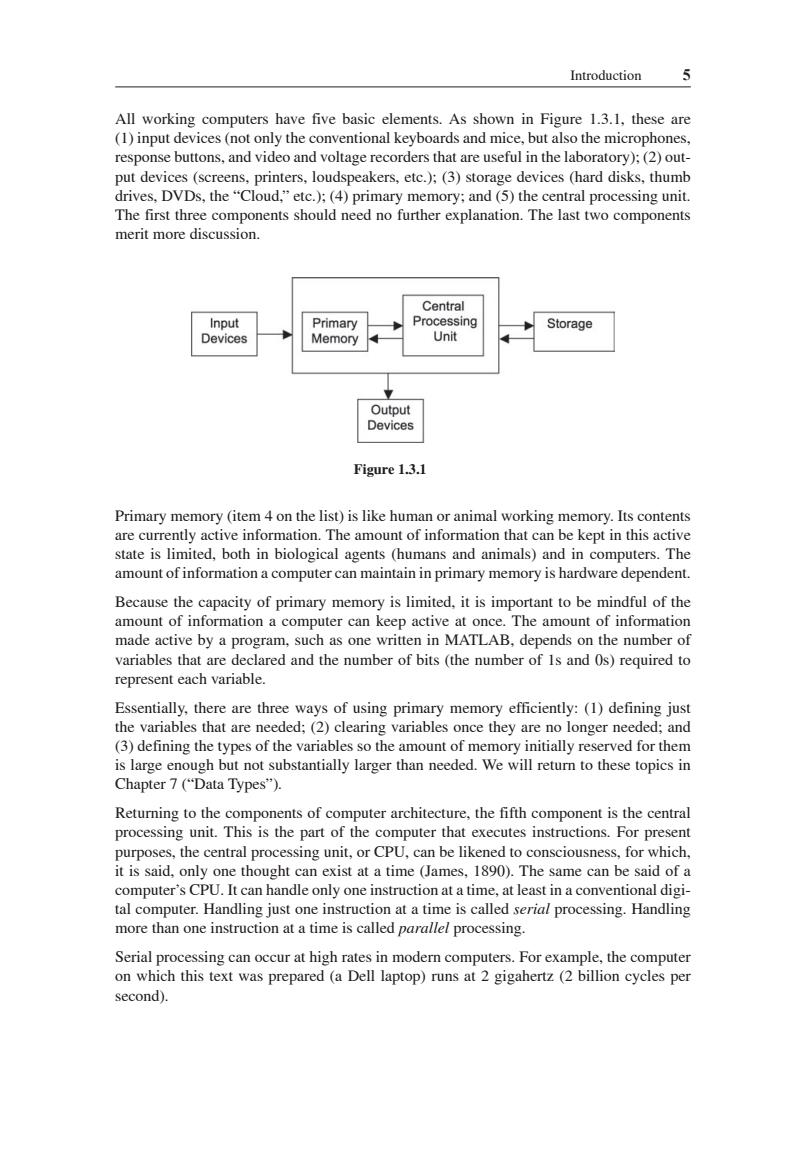正在加载图片...

Introduction 5 All working computers have five basic in Figure 13.1.these are and video and voltas ers that are useful in thea YE(2)S etc )(3) vices (hard disks and (5)the sing The first three c ents should need no further explanation.The last two comp merit more discussion. Central Memory Unit Storage Figure1.3.1 Primary memory (item 4 on the list)is like human or animal working memory.Its contents are currently active information.The amount of information that can be kept in this active state is limited,both in biological agents(humans and animals)and in computers.The amount of information a computer can maintain in primary memory is hardware dependent. Because the capacity of primary memory is limited,it is important to be mindful of the The amount of informatior mac written in MATLAB.depends on th e numbe ared and the number of bits(the number of Is and 0s)required to ed; larger tha nount eded Wewi Chapiter 7(Data Types) Returning to the co nents of comn ter architecture.the fifth c ent is the central processing unit.This is the part of the om puter that executes instructions.For pr ent oses.the central unit or can he likened to c ess,for which d.onl one thou dam 190.The same an be said of computer's CPU.It can handle only one instruction at a time.at least in a conventional digi- tal computer.Handling just one instruction at a time is called serial processing.Handling more than one instruction at a time is called parallel processing. Serial processing can occur at high rates in modern computers.For example,the computer on which this text was prepared (a Dell laptop)runs at 2 gigahertz(2 billion cycles per second).Introduction 5 All working computers have five basic elements. As shown in Figure 1.3.1 , these are (1) input devices (not only the conventional keyboards and mice, but also the microphones, response buttons, and video and voltage recorders that are useful in the laboratory); (2) output devices (screens, printers, loudspeakers, etc.); (3) storage devices (hard disks, thumb drives, DVDs, the „Cloud,‰ etc.); (4) primary memory; and (5) the central processing unit. The first three components should need no further explanation. The last two components merit more discussion. Figure 1.3.1 Primary memory (item 4 on the list) is like human or animal working memory. Its contents are currently active information. The amount of information that can be kept in this active state is limited, both in biological agents (humans and animals) and in computers. The amount of information a computer can maintain in primary memory is hardware dependent. Because the capacity of primary memory is limited, it is important to be mindful of the amount of information a computer can keep active at once. The amount of information made active by a program, such as one written in MATLAB, depends on the number of variables that are declared and the number of bits (the number of 1s and 0s) required to represent each variable. Essentially, there are three ways of using primary memory efficiently: (1) defining just the variables that are needed; (2) clearing variables once they are no longer needed; and (3) defining the types of the variables so the amount of memory initially reserved for them is large enough but not substantially larger than needed. We will return to these topics in Chapter 7 („Data Types‰). Returning to the components of computer architecture, the fifth component is the central processing unit. This is the part of the computer that executes instructions. For present purposes, the central processing unit, or CPU, can be likened to consciousness, for which, it is said, only one thought can exist at a time (James, 1890). The same can be said of a computerÊs CPU. It can handle only one instruction at a time, at least in a conventional digital computer. Handling just one instruction at a time is called serial processing. Handling more than one instruction at a time is called parallel processing. Serial processing can occur at high rates in modern computers. For example, the computer on which this text was prepared (a Dell laptop) runs at 2 gigahertz (2 billion cycles per second)